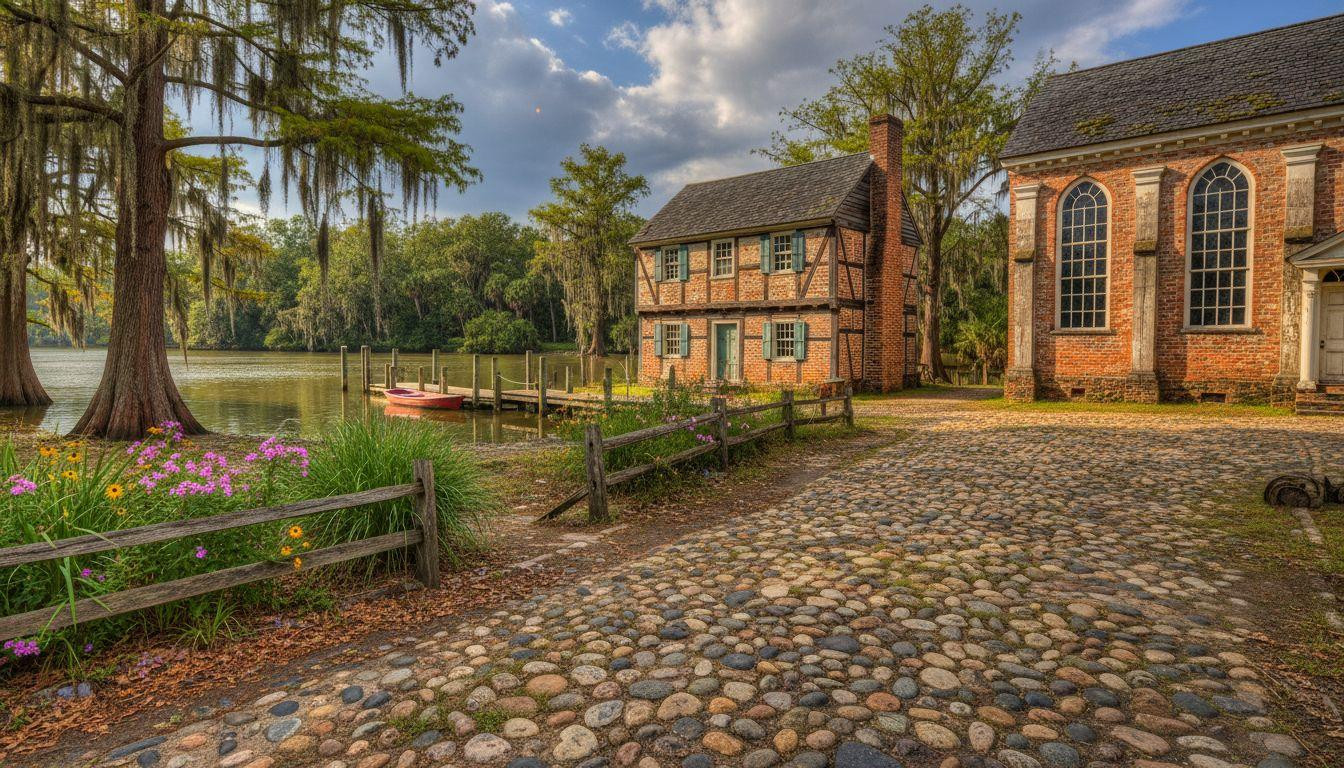Forget Colonial Williamsburg where $35 admission fees and costumed interpreters create Disney-like colonial theater. Two hours east of Raleigh, Bath quietly preserves North Carolina’s authentic 1705 beginnings along the Pamlico River. This overlooked town offers genuine colonial history without crowds, tickets, or performances.
While tourists pay $35 daily at Williamsburg’s reconstructed village, Bath’s 250 residents live among original 18th-century structures. St. Thomas Church still holds Sunday services in the same brick walls completed in 1734.
Why Williamsburg feels manufactured
Colonial Williamsburg attracts 534,000 annual visitors to its meticulously recreated colonial capital. Costumed interpreters deliver scripted presentations about blacksmithing and candlemaking. The experience feels theatrical because most structures are reconstructions built for tourism.
Admission costs $35 for adults, plus parking fees and restaurant prices inflated by captive audiences. The authenticity tourists seek gets buried under commercial necessity. Gift shops outnumber genuine artifacts.
Weekend crowds pack Duke of Gloucester Street while interpreters repeat rehearsed colonial dialogues. The manufactured atmosphere prioritizes entertainment over historical accuracy. Newport’s mansion tours create similar tourist theater.
Meet Bath: North Carolina’s 1705 original
Bath incorporated in 1705 as North Carolina’s first official town and colonial port of entry. Unlike Williamsburg’s reconstructions, Bath preserves original structures where colonial families actually lived and worshipped. The town never needed rebuilding because it never disappeared.
The landscape Williamsburg recreated
Bath’s Pamlico River waterfront provided the natural harbor that made colonial trade possible. Wooden docks still extend into the same brackish waters where 18th-century merchant ships loaded tobacco and naval stores.
St. Thomas Church’s Flemish bond brickwork displays authentic colonial craftsmanship from 1734. The Palmer-Marsh House contains original hand-hewn timbers and colonial-era basement tunnels possibly used by smugglers.
The price of real history
Palmer-Marsh House tours cost $10 compared to Williamsburg’s $35 daily admission. The Bonner House charges another $10 for guided tours through rooms where colonial families actually lived. Ghost tours exploring Blackbeard’s local legends cost $20.
Lodging ranges from $75-120 nightly at local inns versus $200-300 at Williamsburg hotels during peak seasons. Restaurant meals average $10-20 for authentic Eastern Carolina barbecue and fresh Pamlico Sound seafood.
What Bath delivers that Williamsburg cannot
Bath offers encounters with history that exists for preservation, not profit. St. Thomas Church holds active Episcopal services where colonial parishioners once worshipped. The sanctuary’s worn wooden pews and simple colonial altar remain unchanged since 1734.
Activities without admission fees
Walking Bath’s historic district costs nothing and covers the entire town in 30 minutes. Edenton’s lighthouse lies 45 minutes north for extended colonial exploration. Ferry connections to Ocracoke Island provide access to Blackbeard’s Pirate Jamboree during spring and fall seasons.
Pamlico River kayaking and fishing require no reservations or fees. The town’s single main road eliminates navigation confusion that plagues Williamsburg’s sprawling historic area.
Culture without performance
Local historians share Bath’s stories naturally during chance encounters rather than scheduled presentations. The innkeeper whose family has welcomed visitors for decades offers genuine Southern hospitality without scripted colonial roleplay.
Blackbeard’s ghost reportedly haunts Bath Creek, creating local legend more authentic than any costumed interpreter. Remote villages worldwide preserve similar authentic character through benign neglect.
The quiet revelation
Bath preserves what Williamsburg commodified. Morning light touches St. Thomas Church’s brick walls the same way it illuminated colonial worship services 290 years ago. The Pamlico River laps against wooden docks where merchant ships once loaded Carolina exports.
This authenticity cannot be recreated or scheduled. It simply exists, waiting for travelers who value preservation over performance. Historic coastal towns throughout America offer similar discoveries for those willing to seek them.
Your questions about Bath, North Carolina answered
How do I reach Bath from major North Carolina cities?
Bath lies 120 miles east of Raleigh via US-64 E and US-17 N, requiring approximately 2 hours driving time. The town sits 180 miles northeast of Wilmington and 45 miles south of the Outer Banks ferry terminals.
What makes Bath historically significant compared to other colonial sites?
Bath received incorporation as North Carolina’s first official town in 1705 and served as the colony’s original port of entry. St. Thomas Church (1734) remains the state’s oldest surviving church building with active congregation services.
How does Bath compare to Colonial Williamsburg for families?
Bath offers intimate historical exploration suitable for all ages without admission fees or crowds. Williamsburg provides more structured activities and interpretive programs but costs significantly more and attracts larger crowds during peak seasons.
Golden hour light transforms Bath’s weathered brick and silver river into amber reflections. Colonial ghosts seem closer here, where history breathes quietly through original walls rather than shouting from reconstructed stages.
